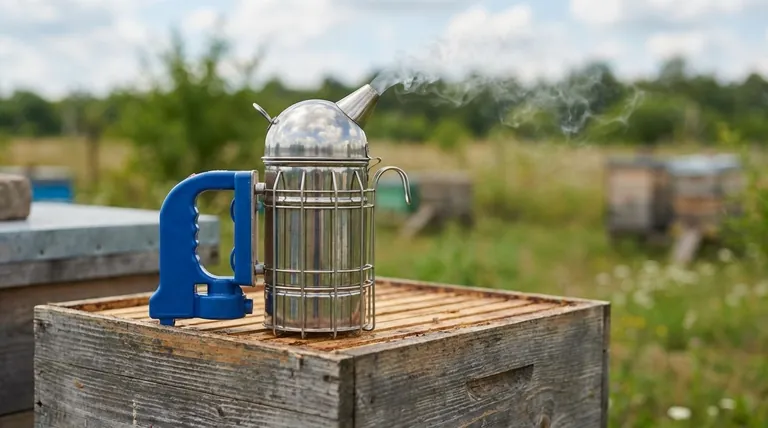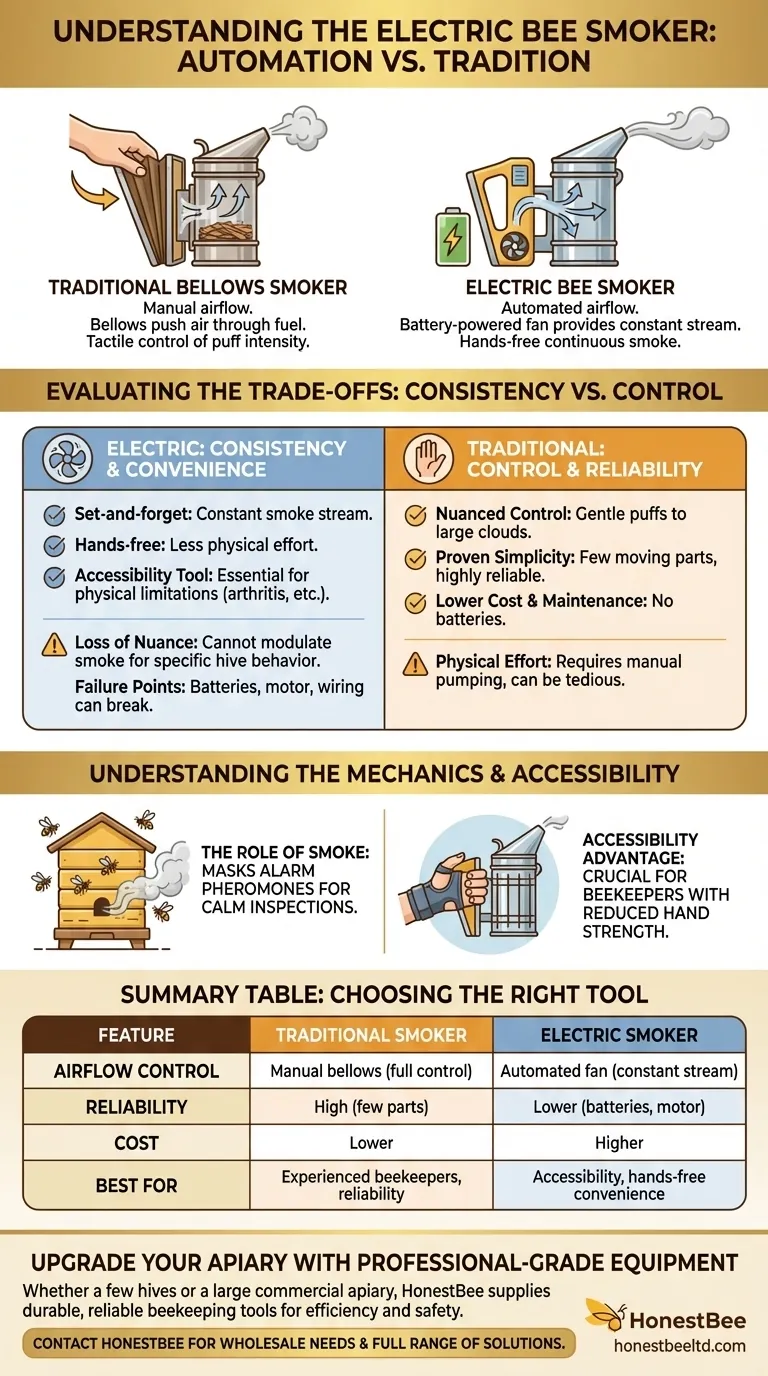At its core, an electric bee smoker is a variation of a traditional smoker that automates the airflow. It replaces the classic, hand-operated bellows with a small, battery-powered fan built into the handle or body. This provides a continuous stream of air to keep the fuel smoldering and produce smoke without the need for manual pumping.
The central trade-off is one of convenience versus control. While an electric smoker offers effortless, consistent smoke, it sacrifices the nuanced control and field-proven simplicity that experienced beekeepers rely on with traditional bellows.

How a Smoker Works: The Fundamental Principle
The Role of Smoke in Beekeeping
Smoke is a critical tool for safely managing honey bee colonies. It works by masking the alarm pheromones, such as isopentyl acetate, that guard bees release when they perceive a threat. This interruption in communication calms the colony and reduces defensive behaviors, allowing the beekeeper to perform inspections.
Traditional Smoker Mechanics
A traditional smoker is a simple, robust device. It consists of a fire chamber for fuel and a set of bellows attached to it. Squeezing the bellows forces a puff of air into the bottom of the chamber, which in turn pushes cool, thick smoke out of the spout. The beekeeper has direct, tactile control over the volume and intensity of each puff.
Electric Smoker Mechanics
An electric smoker functions on the same principle but automates the airflow. Instead of bellows, a small fan, powered by batteries, provides a constant and steady stream of air to the fire chamber. The result is a continuous, hands-free flow of smoke as long as the fan is switched on.
Evaluating the Electric Smoker: Automation vs. Nuance
The Promise of Consistent Smoke
The primary advantage of an electric smoker is its "set it and forget it" nature. Once lit and turned on, it produces a consistent volume of smoke without any further physical effort. This can be helpful during long inspections or for beekeepers who find pumping bellows to be tedious.
The Loss of Granular Control
Experienced beekeepers often use the smoker with great nuance. A tiny, gentle puff might be all that's needed to move a few bees, while a more aggressive colony might require several large, billowing clouds. An electric smoker's constant stream of smoke removes this ability to modulate the output in response to the hive's specific temperament.
The Introduction of Failure Points
The simplicity of a traditional smoker is its greatest strength; there are very few parts that can break. An electric model introduces multiple potential points of failure: dead batteries, a burnt-out motor, faulty wiring, or a switch that fails in the field.
Understanding the Trade-offs
Reliability and Simplicity
A traditional bellows smoker is a time-tested, mechanically simple tool. It does not rely on batteries or electronics, making it exceptionally reliable in any apiary environment. Its function is transparent and easily maintained.
Cost and Maintenance
Electric smokers are invariably more expensive than their traditional counterparts. They also introduce the ongoing maintenance task of ensuring batteries are charged and replacing them when they no longer hold a charge.
An Important Accessibility Tool
The most compelling case for an electric smoker is for beekeepers with physical limitations. Individuals with arthritis, carpal tunnel syndrome, or reduced hand strength may find pumping bellows difficult or painful. For them, an electric smoker is not a luxury but a crucial accessibility tool that enables them to continue practicing beekeeping comfortably.
Making the Right Choice for Your Apiary
The decision between a traditional and electric smoker depends entirely on your priorities and physical needs.
- If your primary focus is reliability, control, and cost-effectiveness: The traditional bellows smoker remains the undisputed standard for its simplicity and robustness.
- If your primary focus is convenience and you prefer a hands-free tool: The electric smoker is a viable option, provided you accept the risks of electronic failure and the loss of nuanced smoke control.
- If you face physical challenges with hand strength or dexterity: The electric smoker is an excellent solution that makes hive management significantly more accessible and comfortable.
Ultimately, the best tool is the one that allows you to work your hives safely and effectively.
Summary Table:
| Feature | Traditional Smoker | Electric Smoker |
|---|---|---|
| Airflow Control | Manual bellows (full control) | Automated fan (constant stream) |
| Reliability | High (few moving parts) | Lower (batteries, motor can fail) |
| Cost | Lower | Higher |
| Best For | Experienced beekeepers, reliability | Accessibility, hands-free convenience |
Upgrade Your Apiary with Professional-Grade Equipment from HONESTBEE
Whether you manage a few hives or run a large commercial apiary, having the right tools is essential for efficiency and bee safety. At HONESTBEE, we supply durable, reliable beekeeping supplies and equipment through wholesale-focused operations to commercial apiaries and distributors.
Let us help you equip your operation for success. Contact HONESTBEE today to discuss your wholesale needs and discover our full range of smokers, protective gear, and hive management solutions.
Visual Guide

Related Products
- Electric Bee Smoker European Style Bee Hive Smoker for Beekeeping
- Stainless Steel Electric Beehive Smoker for Beekeeping and Bee Keeper Use
- European Stainless Steel Bee Smoker for Honey Bee Hive
- Premium Traditional Copper Bee Smoker with Bellows
- Stainless Steel Bee Hive Smoker Beekeeping Smoker for Wholesale
People Also Ask
- What are the methods for cleaning a bee smoker? Restore Optimal Performance and Protect Your Hive
- What does smoke do to honey? Master the Balance for Pure, Untainted Honey
- Does smoke harm bees? The Truth About Safe Beekeeping Practices
- What should you do if you see bees lined up between the frames looking at you? A Guide to Calm and Safe Hive Inspections
- Why do beekeepers use smoke? The Science Behind Calm Hive Inspections



















